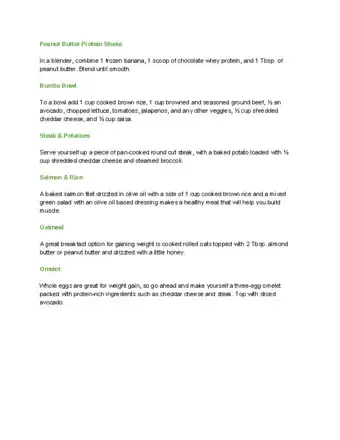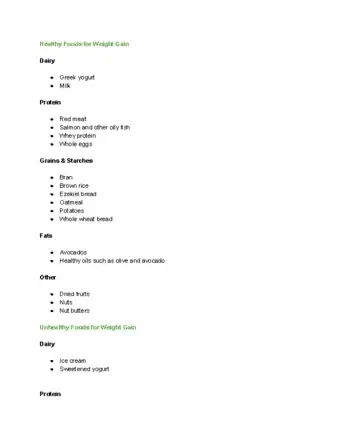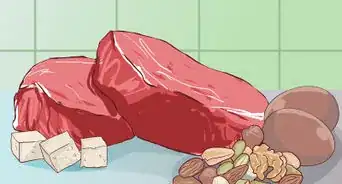This article was co-authored by Claudia Carberry, RD, MS. Claudia Carberry is a Registered Dietitian specializing in kidney transplants and counseling patients for weight loss at the University of Arkansas for Medical Sciences. She is a member of the Arkansas Academy of Nutrition and Dietetics. Claudia received her MS in Nutrition from the University of Tennessee Knoxville in 2010.
There are 16 references cited in this article, which can be found at the bottom of the page.
wikiHow marks an article as reader-approved once it receives enough positive feedback. This article received 24 testimonials and 87% of readers who voted found it helpful, earning it our reader-approved status.
This article has been viewed 3,106,858 times.
For some women, gaining weight can be just as difficult as losing weight might be for others. There are many ways, however, to safely and effectively gain 1–2 pounds (0.45–0.91 kg) a week. Larger portion sizes and more frequent meals are a quick way to add extra calories into your day. Aim for nutrient-dense, high-calorie foods to fill out your meals. Don’t forget to incorporate healthy exercise and other lifestyle changes into your routine to maintain the weight over time.
Steps
Changing Your Eating Habits
-
1Consume an additional 500 calories per day. It is generally safe to gain 1–2 pounds (0.45–0.91 kg) per week. To reach this goal, add an extra 500 calories to your diet every day. The healthiest way to do this is to eat more nutrient-dense foods.[1]
- To keep track of what you’re eating, use a health app, such as MyFitnessPal. Write down everything you eat and how much exercise you do. Once a week, record your weight.
- Talk with your doctor or a registered dietitian to determine your ideal weight. You can also calculate your healthy weight with a Body Mass Index (BMI) calculator. For most people, a healthy BMI falls between 18.5-24.9.[2]
-
2Increase your portion size. Eat a second helping of food or add more food to your plate when you begin. If you’re finding it hard to eat a larger meal, skip snacks so that you have more of an appetite at mealtime.[3]
- If eating a double portion is too much, try increasing the portion over time. Start with an extra scoop of rice or add a sweet potato on the side. As time goes on, slowly add more food to your meal.
Advertisement -
3Eat several small meals if you don’t like larger meals. For some people, eating larger portion sizes may not be an appealing option. Instead of increasing portion sizes, try to eat 6 smaller meals throughout the day. These meals can include breakfast, lunch, dinner, and 3 snacks.[4]
- As a general rule, eat once every 3-4 hours pass while awake.
-
4Avoid drinking 30 minutes before a meal. Liquids can fill you up, making it harder for you to finish a full meal. Wait until after you have finished eating to get a drink.[5]
-
5Indulge in a snack before bed. If you eat a snack or small meal before bed, your body won't have a chance to burn it off before you sleep. Additionally, the body builds more muscle during sleep. Eating a snack before bed supplies your body with the nutrients it needs to build more lean muscle as you sleep.[6]
-
6Stimulate your appetite before eating meals. There are many things you can do to feel hungrier before eating. These tricks can help you eat more at a meal. Some easy ways to increase your appetite include:[7]
- Take a short walk before meals. Exercise can help you feel hungrier.
- Prepare foods that you enjoy. Make your favorite comfort food to encourage yourself to eat it all.
- Try new recipes. This can help you feel more excited about trying your meal.
- Eat in a calm, comfortable atmosphere. If you’re tense or distracted, you may not want to eat as much.
Choosing the Right Foods and Drinks
-
1Consume high-calorie and nutrient-dense foods. Fast food and processed meals may be high in calories, but they provide empty calories that don’t contain many nutrients. Nutrient-dense foods pack in more calories and more good fats, protein, vitamins, and minerals.[8]
- For grains, eat heavy breads like whole wheat and pumpernickel. Bran muffins, whole wheat bread, and wheat germ are also good choices.
- When it comes to fruit, choose bananas, pineapples, raisins, dried fruit, and avocados. In general, starchy fruits are preferable to water-rich fruits, like watermelon or oranges, as they contain more calories and nutrients.
- For vegetables, try peas, corn, potatoes, and winter squash. As with fruit, starchy vegetables are better than water-rich vegetables.
- Within the dairy group, consider cheese, ice cream, frozen yogurt, and whole milk.
-
2Aim for 3 food groups in a meal. When eating a snack or meal, don’t just eat 1 type of food. Incorporate a few different food groups into each meal. This will increase the calorie count while making it easier for you to eat more.[9]
- For example, don’t just eat toast. Try to top the toast with peanut butter and adding sliced bananas on top. Or place sliced avocado on top with a glass of kefir on the side.
- If you enjoy eggs in the morning, try scrambling them with peppers and sausage.
- Instead of just eating a cup of yogurt, sprinkle granola and berries on top.
-
3Drink more of your food if you struggle with solid meals. Sometimes, it can be hard to motivate yourself to eat extra snacks. Try drinking high-calorie drinks in between meals if you can't stomach a snack.[10]
- Smoothies are great, especially those made with whole fruits and vegetables and yogurt.
- Juice made from real fruit adds extra vitamins and fiber to your meal.
- Milk, milkshakes, protein shakes are also good options.
-
4Add extra ingredients to meals. You can stir high-calorie, nutritious foods or powders into your favorite meals to add extra calories without making you feel much fuller. Some great ways to do this include:[11]
- Stir powdered milk into beverages, soups, stews, and sauces.
- Sprinkle nuts over your salad or cereal.
- Stir ground flaxseed into salads, cereals, and smoothies.
- Sprinkle cheese over your casseroles, soups, scrambled eggs, salads, and sandwiches.
- Spread butter, nut butter, or cream cheese over toast, crackers, or rolls.
-
5Cook with oil and butter. Cooking foods in oil and butter will increase a dish's total number of calories without adding more food to your plate. Good fats to cook with include:[12]
- Olive oil, which contains 119 calories per 1 Tbsp (15 ml).
- Canola oil, which contains 120 calories per 1 Tbsp (15 ml).
- Coconut oil, which contains 117 calories per 1 Tbsp (15 ml).
- Butter, which contains 102 calories per 1 Tbsp (15 ml).
-
6Consume more protein if you want to build muscle. Muscle weighs more than body fat, which means that building muscle is a great way to gain weight without gaining fat. Protein is essential to helping your body build muscle mass.[13]
- Lean meats and eggs are great sources of protein. Some good vegetarian options include peas, nuts, hummus, and beans.
- Protein bars and shakes make for great snacks. They pack in extra protein and other nutrients.
Adjusting Your Lifestyle
-
1Treat any underlying medical conditions. Certain medications and conditions can make it hard to gain weight. If this is the case, make sure you’re treating your medical condition. Talk to your doctor to find the right options for you.[14]
- If you have lost a significant amount of weight without explanation, see your doctor to make sure that you do not have an underlying condition, such as a thyroid or digestive disorder.
-
2Talk to a registered dietitian. A registered dietitian can help you design meal plans to help you reach your weight goals in a healthy manner. They can also provide advice about exercising or stimulating your appetite.[15]
- Ask your doctor to refer you to a registered dietitian.
-
3Quit smoking. Smoking suppresses your appetite and can affect your sense of taste and smell. Talk to your doctor to discuss strategies for quitting smoking. Your doctor may be able to prescribe a path or pill to help you quit.[16]
- If you cannot quit smoking, try to avoid smoking for an hour or 2 before you eat a meal.
-
4Start strength training to build muscle. While not the fastest option, strength training is a good idea if you want to keep weight on long-term. Exercise is a good way to whet your appetite. Strength training, in particular, is especially good because it allows you to gain weight by building your muscles.[17]
- Weight training is a great place to start. You can also do body weight exercises like yoga or Pilates. Avoid too much cardio or aerobic exercise, as they may prevent you from gaining weight.
- Eating extra protein is especially important if you plan to build muscle mass through exercise.
- Good strength training exercises include squats, deadlifts, overhead presses, bench presses, barbell rows, dips, chin-ups, crunches, bicep curls, leg presses, and leg curls.
Sample Foods and Meals to Gain Weight
Expert Q&A
-
QuestionIs it possible to gain weight within a week even though I smoke a lot?
 Claudia Carberry, RD, MSClaudia Carberry is a Registered Dietitian specializing in kidney transplants and counseling patients for weight loss at the University of Arkansas for Medical Sciences. She is a member of the Arkansas Academy of Nutrition and Dietetics. Claudia received her MS in Nutrition from the University of Tennessee Knoxville in 2010.
Claudia Carberry, RD, MSClaudia Carberry is a Registered Dietitian specializing in kidney transplants and counseling patients for weight loss at the University of Arkansas for Medical Sciences. She is a member of the Arkansas Academy of Nutrition and Dietetics. Claudia received her MS in Nutrition from the University of Tennessee Knoxville in 2010.
Master's Degree, Nutrition, University of Tennessee Knoxville Master's Degree, Nutrition, University of Tennessee KnoxvilleExpert AnswerIt is possible to gain 1-2 pounds in a week by adding an extra 500-1,000 calories per day using the strategies in this article. That said, it would be better for your health to quit smoking.
Master's Degree, Nutrition, University of Tennessee KnoxvilleExpert AnswerIt is possible to gain 1-2 pounds in a week by adding an extra 500-1,000 calories per day using the strategies in this article. That said, it would be better for your health to quit smoking. -
QuestionI have been eating a lot for the past 3 months, and I've still seen no difference in my weight. This is very discouraging for me. How long does it take to gain weight?
 Claudia Carberry, RD, MSClaudia Carberry is a Registered Dietitian specializing in kidney transplants and counseling patients for weight loss at the University of Arkansas for Medical Sciences. She is a member of the Arkansas Academy of Nutrition and Dietetics. Claudia received her MS in Nutrition from the University of Tennessee Knoxville in 2010.
Claudia Carberry, RD, MSClaudia Carberry is a Registered Dietitian specializing in kidney transplants and counseling patients for weight loss at the University of Arkansas for Medical Sciences. She is a member of the Arkansas Academy of Nutrition and Dietetics. Claudia received her MS in Nutrition from the University of Tennessee Knoxville in 2010.
Master's Degree, Nutrition, University of Tennessee Knoxville Master's Degree, Nutrition, University of Tennessee KnoxvilleExpert AnswerIf you are maintaining your weight, that means that you are burning as many calories as you are eating. Try adding some extra snacks or liquid calories, such as smoothies or protein shakes, to tilt your intake towards weight gain.
Master's Degree, Nutrition, University of Tennessee KnoxvilleExpert AnswerIf you are maintaining your weight, that means that you are burning as many calories as you are eating. Try adding some extra snacks or liquid calories, such as smoothies or protein shakes, to tilt your intake towards weight gain.
References
- ↑ https://youngwomenshealth.org/parents/promoting-healthy-weight-gain-parent/
- ↑ https://www.nhlbi.nih.gov/health/educational/lose_wt/BMI/bmicalc.htm
- ↑ https://youngwomenshealth.org/parents/promoting-healthy-weight-gain-parent/
- ↑ https://youngwomenshealth.org/parents/promoting-healthy-weight-gain-parent/
- ↑ https://www.mayoclinic.org/healthy-lifestyle/nutrition-and-healthy-eating/expert-answers/underweight/faq-20058429
- ↑ http://www.shape.com/blogs/weight-loss-coach/5-ways-gain-weight-healthy-way
- ↑ https://www.urmc.rochester.edu/encyclopedia/content.aspx?contenttypeid=34&contentid=18346-1
- ↑ https://medlineplus.gov/ency/patientinstructions/000617.htm
- ↑ https://www.shape.com/blogs/weight-loss-coach/5-ways-gain-weight-healthy-way
- ↑ https://www.mayoclinic.org/healthy-lifestyle/nutrition-and-healthy-eating/expert-answers/underweight/faq-20058429
- ↑ https://medlineplus.gov/ency/patientinstructions/000617.htm
- ↑ https://youngwomenshealth.org/parents/promoting-healthy-weight-gain-parent/
- ↑ https://youngwomenshealth.org/parents/promoting-healthy-weight-gain-parent/
- ↑ https://www.mayoclinic.org/symptoms/unexplained-weight-loss/basics/definition/SYM-20050700?p=1
- ↑ https://youngwomenshealth.org/parents/promoting-healthy-weight-gain-parent/
- ↑ https://www.urmc.rochester.edu/encyclopedia/content.aspx?contenttypeid=34&contentid=18346-1
- ↑ http://www.mayoclinic.com/health/underweight/AN00597
About This Article
If you’re a woman and you want to gain weight fast, try adding an extra 500 calories to your diet every day. If you want to do this in a healthy way, obtain these calories from nutrient-dense foods like whole grain bread and pasta, avocados, and hummus. Cook with oil and butter whenever you can, and try adding in high-calorie toppings like cheese, nuts, cream cheese, or butter on top of dishes you already enjoy. Keep reading for tips from our dietary reviewer on how to build muscle while you’re adding weight!
-Step-1-Version-4.webp)
-Step-2-Version-2.webp)
-Step-3-Version-3.webp)
-Step-4-Version-3.webp)
-Step-5-Version-3.webp)
-Step-6-Version-3.webp)
-Step-7-Version-3.webp)
-Step-8-Version-2.webp)
-Step-9-Version-3.webp)
-Step-10-Version-2.webp)
-Step-11-Version-3.webp)
-Step-12-Version-2.webp)
-Step-13-Version-2.webp)
-Step-14-Version-2.webp)
-Step-15-Version-2.webp)
-Step-16-Version-2.webp)




-Step-14.webp)























-Step-14.webp)





































